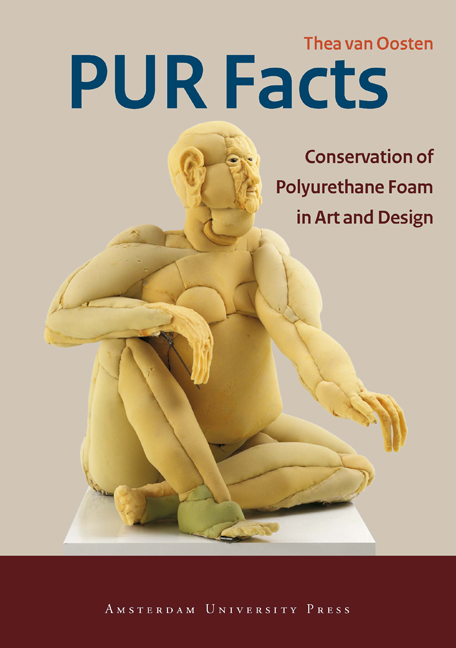Book contents
- Frontmatter
- Contents
- Preface
- Introduction
- 1 Polyurethanes, Manufacture and Applications
- 2 Chemistry, Properties and Degradation
- 3 History of Polyurethane foam Conservation
- 4 Ageing Behaviour of Polyurethane foam
- 5 Assessing the Condition of Polyurethane foam
- 6 Case Studies
- Acknowledgements
- Glossary
- General Information
- Bibliography
2 - Chemistry, Properties and Degradation
Published online by Cambridge University Press: 14 January 2021
- Frontmatter
- Contents
- Preface
- Introduction
- 1 Polyurethanes, Manufacture and Applications
- 2 Chemistry, Properties and Degradation
- 3 History of Polyurethane foam Conservation
- 4 Ageing Behaviour of Polyurethane foam
- 5 Assessing the Condition of Polyurethane foam
- 6 Case Studies
- Acknowledgements
- Glossary
- General Information
- Bibliography
Summary
Introduction
The history of polyurethanes dates back to the chemistry of isocyanates in the year 1849, when Würtz reported the synthesis of isocyanate. It was not until after 1945, however, that the synthesis of isocyanates became commercially important for the polyurethane industry. The simple reaction of an alcohol and an isocyanate results in the formation of an urethane linkage (1).
Polyurethanes are formed by the reaction of a polyol (an alcohol with at least two reactive hydroxyl groups per molecule) with a diisocyanate or a polymeric isocyanate. The most widely used method for the preparation of polyurethane is the additional reaction between di- or polyfunctional hydroxyl compounds, such as hydroxyl-terminated polyethers or polyesters and di- or polyfunctional isocyanates in the presence of suitable catalysts and additives. In polyurethanes, the polyol component is the long (1000-2000 nm), flexible segment and the diisocyanate is the short (150 nm), rigid segment, chemically and hydrogen bonded together (Figure 33).
The final polymer is formed in two separate steps. The diisocyanate and the polyol react together to form an intermediate polymer called the prepolymer, which is usually a viscous thick liquid or low melting solid (Figure 33).
The prepolymer is converted into the high-molecular-weight polymer by further reaction with a diol or diamine chain extender. This step is the chain extender stage, though sometimes the term cross-linking is used if this better represents the character of the final polymer. Alternatively, the entire polymer formation may be carried out by simultaneously mixing together polyol, diisocyanate, chain extender and catalysts in the so-called one-shot process.
Depending on the polyols, isocyanates, chain extenders, cross-linkers and other additives used, a variety of polyurethanes can be produced, varying from thermoplastic soft to rigid elastomers, thermoplastic fibres, thermoplastic adhesives and coatings, and thermoplastic-thermosetting coatings and thermosetting (cross-linked) foams, from flexible to semi-rigid to rigid and to micro-cellular foams (memory foams). In all polyurethanes the hardness ranges from soft jelly structures to hard rigid plastics. Properties are related to segmented flexibility, chain entanglement, interchain forces and cross-linking (Figure 34).
Depending on the polyols, isocyanates, chain extenders, cross-linkers and other additives used, various reactions take place, e.g. the end-standing urethane can react again with a polyol.
- Type
- Chapter
- Information
- PUR FactsConservation of Polyurethane Foam in Art and Design, pp. 29 - 46Publisher: Amsterdam University PressPrint publication year: 2011



